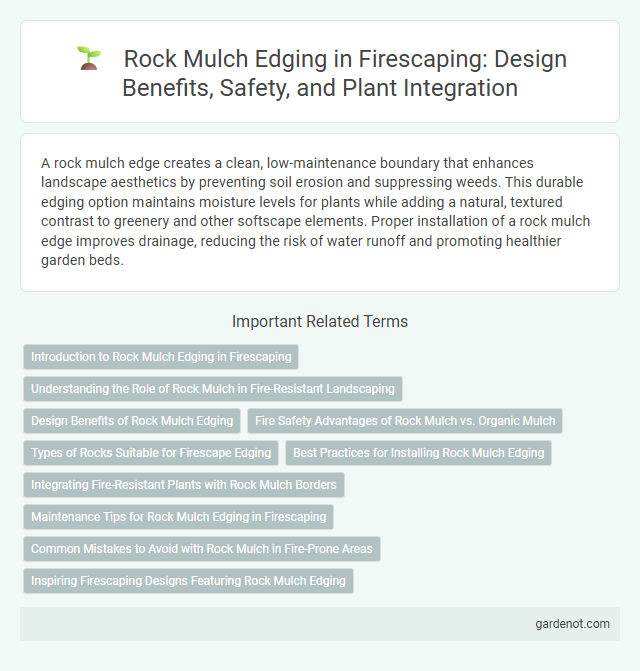A rock mulch edge creates a clean, low-maintenance boundary that enhances landscape aesthetics by preventing soil erosion and suppressing weeds. This durable edging option maintains moisture levels for plants while adding a natural, textured contrast to greenery and other softscape elements. Proper installation of a rock mulch edge improves drainage, reducing the risk of water runoff and promoting healthier garden beds.
Introduction to Rock Mulch Edging in Firescaping
Rock mulch edging in firescaping serves as a fire-resistant barrier that reduces the spread of flames by limiting combustible materials near structures. Its dense, non-flammable composition helps create a defensible space, enhancing fire protection around homes and landscapes. Proper installation of rock mulch edges improves soil moisture retention and reduces weed growth, supporting both fire safety and ecosystem health.
Understanding the Role of Rock Mulch in Fire-Resistant Landscaping
Rock mulch edge serves as a crucial barrier in fire-resistant landscaping by reducing the availability of combustible materials near structures. Its non-flammable properties help slow wildfire spread and protect soil moisture, enhancing plant resilience during dry conditions. Incorporating rock mulch edges around garden beds and pathways optimizes fire safety while maintaining aesthetic appeal.
Design Benefits of Rock Mulch Edging
Rock mulch edging enhances firescaping by creating a non-combustible barrier that reduces wildfire fuel near structures. Its design benefits include increased durability compared to organic mulches, effective moisture retention for adjacent plants, and improved aesthetic appeal through clean, defined landscape lines. This edging method also minimizes soil erosion and helps maintain plant health by regulating soil temperature and preventing weed growth.
Fire Safety Advantages of Rock Mulch vs. Organic Mulch
Rock mulch edges provide superior fire safety by acting as a non-combustible barrier that prevents flames from spreading into planted areas. Unlike organic mulch, which can ignite easily due to its dry, flammable nature, rock mulch resists heat and slows the progression of fire toward structures. This fire-resistant property makes rock mulch an essential component in defensible space landscaping in high-risk wildfire zones.
Types of Rocks Suitable for Firescape Edging
Rock mulch edges in firescaping commonly use materials such as lava rock, river rock, and granite due to their heat resistance and durability. Lava rock's porous texture allows for water retention, helping to reduce fire risk by maintaining moisture levels near plants. Granite and river rock provide a dense barrier that resists ignition and effectively suppresses weed growth, enhancing fire safety around landscaping.
Best Practices for Installing Rock Mulch Edging
Rock mulch edging requires a solid base prepared by removing sod and compacting the soil to ensure stability and prevent shifting. Using landscape fabric beneath the rocks minimizes weed growth while allowing water permeability. Properly selecting rock size, layering larger rocks at the bottom and smaller on top, enhances durability and maintains an attractive, functional firescape border.
Integrating Fire-Resistant Plants with Rock Mulch Borders
Rock mulch edges create effective firebreaks by combining non-flammable materials with fire-resistant plants such as succulents, lavender, and rosemary. This integration reduces combustible vegetation near structures, minimizing wildfire risk while maintaining aesthetic appeal. Proper placement and maintenance of rock mulch borders enhance fire resilience in landscaped areas.
Maintenance Tips for Rock Mulch Edging in Firescaping
Rock mulch edging requires regular inspection to ensure rocks remain securely in place and do not create gaps that can allow fire embers to penetrate. Clearing debris such as leaves and pine needles from the rock mulch reduces combustible material near fire-prone areas. Periodically replenishing the rock mulch maintains an effective barrier, while using non-flammable edging materials like metal or stone helps prevent fire spread.
Common Mistakes to Avoid with Rock Mulch in Fire-Prone Areas
Rock mulch edges near structures can create gaps that allow embers to accumulate and ignite debris, increasing fire risk. Using large rocks that retain heat long after sunset can radiate heat towards buildings, compromising fire safety. Avoid placing rock mulch directly adjacent to wooden decks or siding to prevent creating a combustible ignition zone.
Inspiring Firescaping Designs Featuring Rock Mulch Edging
Rock mulch edging enhances firescaping designs by providing a natural, fire-resistant barrier between plantings and ignition sources. Its durable texture and thermal mass help reduce weed growth and soil erosion while complementing various fire-adapted landscapes. Incorporating rock mulch edges not only boosts safety but also adds an aesthetically pleasing, low-maintenance element to fire-wise gardens.
Rock mulch edge Infographic

 gardenot.com
gardenot.com